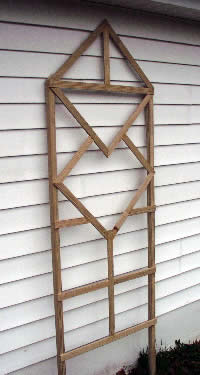Make a Trellis for Climbing Plants
 A trellis may not only be a necessity for the growth and floral display of particular plants, it can also add a new visual element to your garden. Visit any home and garden store or peruse a gardening catalog and you are sure to find many options for trellises, both beautiful and functional. Some will be elaborate copper creations and others simple wooden constructions. Each serves the purpose of supporting a climbing plant. When designing and building a trellis, you, too, can opt for a clean and simple or more complex trellis.
A trellis may not only be a necessity for the growth and floral display of particular plants, it can also add a new visual element to your garden. Visit any home and garden store or peruse a gardening catalog and you are sure to find many options for trellises, both beautiful and functional. Some will be elaborate copper creations and others simple wooden constructions. Each serves the purpose of supporting a climbing plant. When designing and building a trellis, you, too, can opt for a clean and simple or more complex trellis.
 First, determine the needs of your plants that need support. Some plants, such as Morning Glories, will climb poles that are 8 feet high while garden peas are content to attach themselves to lengths of string stretched down the row, just 2 feet from the ground. You can even put a small trellis in a large flower pot for a smaller vertical display.
First, determine the needs of your plants that need support. Some plants, such as Morning Glories, will climb poles that are 8 feet high while garden peas are content to attach themselves to lengths of string stretched down the row, just 2 feet from the ground. You can even put a small trellis in a large flower pot for a smaller vertical display.
 Some favorite floral climbers are Clematis, Morning Glories, and Moonflowers. Many vegetables can be grown vertically, saving garden space, such as pole beans, peas, squash, melons, cucumbers,and certain varieties of tomatoes. (Larger fruits/vegetables will need support as they grow. Try ladies’ nylons, tied to the support, to make slings.)
Some favorite floral climbers are Clematis, Morning Glories, and Moonflowers. Many vegetables can be grown vertically, saving garden space, such as pole beans, peas, squash, melons, cucumbers,and certain varieties of tomatoes. (Larger fruits/vegetables will need support as they grow. Try ladies’ nylons, tied to the support, to make slings.)
 How To Make a Trellis
How To Make a Trellis
1. Determine desired height, according to needs of plant. Also consider the width of the cross-pieces of the trellis. e.g. Sweet Peas are tight-climbers and are content with a grid of string on a sturdy frame.
2. Choose location for trellis. Will you attach it to your house or railing? Will it need to be free-standing, and therefore be buried at least one foot into the ground? Is the location particularly windy?
3. Grab paper, pencil, and ruler. Get creative! If you’re stumped, use elements from trellises you have seen in stores. Remember, it doesn’t have to be complicated and fancy. You plants will cover it soon, anyway.
| Frame Materials | Binding Materials |
|
Pressure-treated lumber
|
galvanized nails, screws
|
For a no-frills trellis, stretch chicken wire or nylon netting between sturdy poles.






